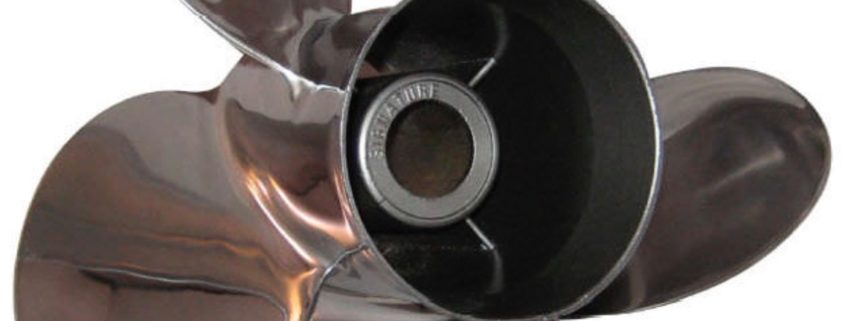Choosing the correct prop for your boat can mean the difference between a well performing motor, and an engine that is low on power which is lugging or over revving. A lugging or over revving engine will eventually fail to engine damage. The prop must be for the proper application, be it an outboard, inboard, or I/O, a noticeable differences being the hub design, hub diameter, and spline.
The most important features of the prop is the diameter and pitch, as this will determine the rpm of the engine. It is very important that the engine operates in the proper rpm range of the engine determined by the manufacturer. For a proper rpm test an actual water test will need to be performed. The engine will need to be run up to full throttle operation and trimmed for optimum performance. The tachometer must be in proper operating condition for making the correct choice of prop. The motor must not be allowed to over rev. Once the rpm is determined the correct prop choice can be made. If the engine is over revving, a higher pitch prop is required, and if the engine is running at a too low of a rpm a lower pitch prop is needed to bring up the rpm. The more pitch in a prop the more water the prop will move in one revolution of the prop. A 2″ change of pitch will in most cases change the rpm by 300-400 rpm. Engines normally can use two different pitch propellers, say a 19p and a 21p and stay in the operating rpm range. The lower pitch prop would be considered a power prop as it will run at a higher rpm and have much more torque, which is good for heavy loads or sking. The higher pitch prop would be considered the speed prop as you would loose your bottom end (torque) but gain on speed as you would be pushing more water at the same rpm. A prop for example, 14 1/2 x 19 would have a total diameter of 14 1/2 inches and a 19 pitch. [expander_maker id=”2″ more=”Read more” less=”Read less”]
Now the question, aluminum or stainless steel? There is pros and cons for both. The aluminum prop is a good economy prop, as the price is within reason for the average boater. It will have some flex and can be damaged easily. But on the other hand minor repairs are cheap, and if you hit something hard you are more likely to damage the prop verses something in the gearcase. Now with a stainless prop which is much more expensive there will be less flex and better performance, but with a stainless prop if you hit something damage to the gearcase is more likely to occur.
The last thought that may come to mind is a 3 blade or 4 blade prop? A three blade prop does quite well for normal use, but you may consider a 4 blade if you are having problems with blow outs, ventilation, or cavitation. A four blade prop will give you a much better hole shot, less slippage, but the top end will not normally improve and with a possibility of dropping a few rpm. Performance boats and bass boats are good candidates for this prop.

